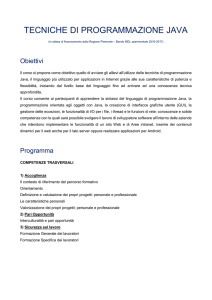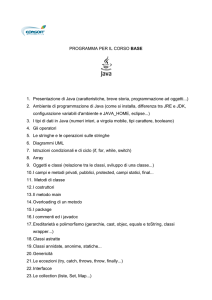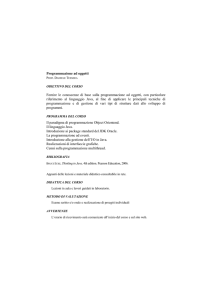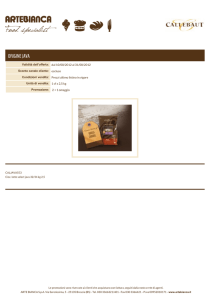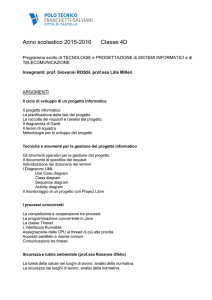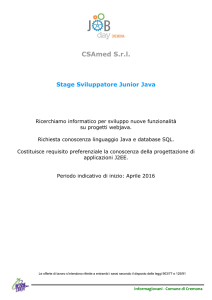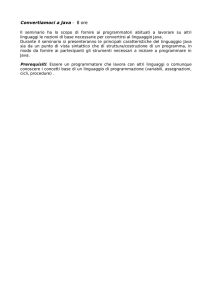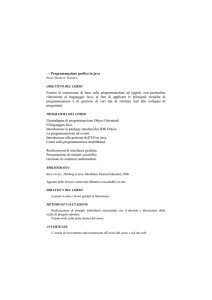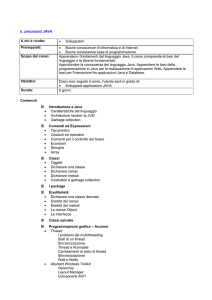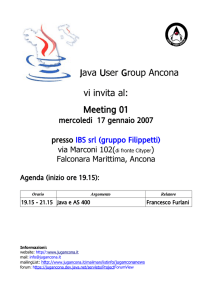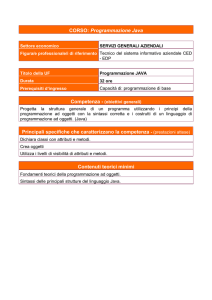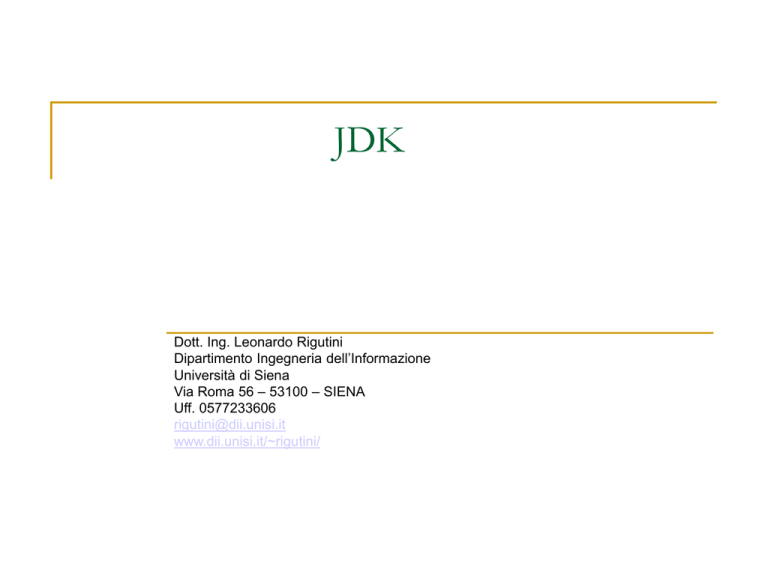
JDK
Dott. Ing. Leonardo Rigutini
Dipartimento Ingegneria dell’Informazione
Università di Siena
Via Roma 56 – 53100 – SIENA
Uff. 0577233606
[email protected]
www.dii.unisi.it/~rigutini/
Libreria standard JAVA
Fornisce una grande varietà di classi per facilitare lo sviluppo di
applicazioni
Organizzata come una gerarchia di packages
Disponibile il JavaDOC in rete:
http://java.sun.com/j2se/1.5.0/docs/index.html
Vediamo le classi principali che potrebbero essere utili nello
sviluppo di applicazioni
Gerarchia
java
java.lang
java.io
java.util
java.math
java.text
java.applet
java.awt
java.sql
java.beans
javax
javax.swing
javax.sql
javax.xml
java.net
java.rmi
java.security
java.lang
Tratto dal javaDoc
Class Summary
Boolean
The Boolean class wraps a value of the primitive type
boolean in an object.
Byte
The Byte class wraps a value of primitive type byte in an
object.
Character
The Character class wraps a value of the primitive type
char in an object.
Double
The Double class wraps a value of the primitive type
double in an object.
Float
The Float class wraps a value of primitive type float in an
object.
java.lang
Class Summary
Integer
The Integer class wraps a value of the primitive type int
in an object.
Long
The Long class wraps a value of the primitive type long
in an object
Math
The class Math contains methods for performing basic
numeric operations such as the elementary exponential,
logarithm, square root, and trigonometric functions.
String
The String class represents character strings.
System
The System class contains several useful class fields
and methods.
Thread
A thread is a thread of execution in a program.
Throwable
The Throwable class is the superclass of all errors and
exceptions in the Java language.
La classe Object
Come già detto la classe Object è la classe root di tutte le classi
Fornisce una serie di funzioni che normalmente devono essere
sovrascritte (override)
Vedere JavaDoc
Classi wrapper
Come si vede esistono nel package molte classi che sembrano
avere lo stesso nome dei tipi di dato semplici:
Boolean, Double, Float, Integer, ecc …
Queste classi sono dette classi wrapper e sono utilizzate per
“wrappare” i tipi di dato semplice in classi:
double indica una variabile che memorizza valori con virgola di tipo
double;
Double è un oggetto che rappresenta un double che ha particolari
metodi per la lettura, la conversione dei double, ecc …
Vedere il JavaDoc
Classe String
La classe String rappresenta le stringhe di caratteri. Ogni parola,
frase, documento è una stringa di caratteri.
La classe String include metodi per esaminare i singoli caratteri,
comparare stringhe, ricercare ed estrarre sottostringhe, portare tutto
minuscolo o maiuscolo, concatenare ecc …
JavaDoc
La classe math
La classe Math mette a disposizioni funzioni matematiche statiche
che possono essere quindi utilizzate senza necessità di istanziare
oggetti di tipo Math:
double a=1.44;
double b=3;
double c=Math.sqrt(a); c=1.2
double p=Math.pow(a,b); p = 2,9859
Fornisce anche due costanti statiche di tipo double :
Math.E numero di nepero (e=2,71)
Math.PI pi greco (pi=3.14)
Vedere il JavaDoc
La classe System
La classe System contiene alcune variabili e funzioni di sistema:
Lo stdout, sterr e stdin sono variabili statiche di questa classe
JavaDoc
Il package java.io
Questo package fornisce classi per facilitare la lettura e scrittura di
dati
L’idea è che ogni operazione di Input/Output avviene tramite uno
stream:
oggetto che realizza un flusso di dati che possono essere letti o scritti
Per facilitare operazioni più complesse il JDK mette a disposizione
classi Reader e Writer:
Le classi Reader si agganciano a stream di input e permettono la lettura
dei dati
Le classi Writer si agganciano a stream di output e permettono la
scrittura di dati
I/O
L’idea è quella di creare una pipeline tra stream ed operazione:
InputStream->Reader->Lettura
OutputStream->Writer->Scrittura
Tale pipeline viene realizzata creando a cascata oggetti che
prendono in ingresso gli oggetti a cui si devono agganciare:
FileInputStream fis=new FileInputStream(“c:\\prova.txt”);
InputStreamReader isr=new InputStreamReader(fis);
String carattereletto=isr.read();
…
isr.close();
fis.close();
I/O
Per alcuni stream comuni le classi Reader e Writer hanno lo stream
nascosto al loro interno:
FileReader fis=new FileReader(“c:\\temp\prova.txt”);
fis.read();
…
fis.close();
Per leggere più di un carattere alla volta è necessario utilizzare un
BufferedReader che si aggancia ad un Reader:
FileReader fis=new FileReader(“c:\\temp\prova.txt”);
BufferedReader br=new BufferedREader(fis);
br.readLine();
…
br.close();
fis.close();
Il package java.io
Class Summary
BufferedInputStream
A BufferedInputStream adds functionality to another input
stream-namely, the ability to buffer the input and to
support the mark and reset methods.
BufferedOutputStream The class implements a buffered output stream.
BufferedReader
Read text from a character-input stream, buffering
characters so as to provide for the efficient reading of
characters, arrays, and lines.
BufferedWriter
Write text to a character-output stream, buffering
characters so as to provide for the efficient writing of
single characters, arrays, and strings.
File
An abstract representation of file and directory
pathnames.
FileInputStream
A FileInputStream obtains input bytes from a file in a file
system.
FileOutputStream
A file output stream is an output stream for writing data to
a File or to a FileDescriptor.
Il package java.io
Class Summary
FileReader
Convenience class for reading character files.
FileWriter
Convenience class for writing character files.
InputStream
This abstract class is the superclass of all classes
representing an input stream of bytes.
OutputStream
This abstract class is the superclass of all classes
representing an output stream of bytes.
OutputStreamWriter
An OutputStreamWriter is a bridge from character streams
to byte streams: Characters written to it are encoded into
bytes using a specified charset.
PrintStream
A PrintStream adds functionality to another output stream,
namely the ability to print representations of various data
values conveniently.
PrintWriter
Print formatted representations of objects to a text-output
stream.
Reader
Abstract class for reading character streams.
Il package java.io
Class Summary
StreamTokenizer
The StreamTokenizer class takes an input stream and
parses it into "tokens", allowing the tokens to be read
one at a time.
StringReader
A character stream whose source is a string.
StringWriter
A character stream that collects its output in a string
buffer, which can then be used to construct a string.
Writer
Abstract class for writing to character streams.
I Thread
L’esecuzione di una funzione di una classe è bloccante:
Quando i compiti da svolgere sono “indipendenti” è possibile
eseguire una funzionalità in modalità nascosta:
thread
In java esistono due modalità per eseguire una funzionalità in
modalità nascosta:
prima di passare oltre è necessario attendere che la funzione sia
terminata
La classe Thread
La classe Runnable
Tale soluzione può essere utilizzata per eseguire operazioni in
parallelo
La classe Thread
La classe Thread è una classe fornita nel JDK
Per eseguire una funzionalità in modalità thread:
1.
rendere la classe che implementa la funzionalità come classe derivata di
Thread:
public class Esempio exends Thread
1.
implementare la funzione run() della classe realizzando la funzionalità
desiderata
1.
In esecuzione, creare oggetti di quel tipo e avviarli in modalità thread
utilizzando la funzione start():
Esempio e=new Esempio();
e.start();
La classe Runnable
In realtà la classe Thread è una implementazione della classe
Runnable
E’ possibile creare un thread:
1.
implementando l’interface Runnable:
public class Esempio implements Runnable
1.
2.
Implementando il metodo run()
In esecuzione passare la classe Runnable ad un oggetto Thread ed
eseguire il metodo start():
Esempio e=new Esempio();
Thread T=new Thread(e);
T.start();
Sincronizzazione di Thread
Quando più thread accedono a funzioni o variabili condivise sussiste
un problema di programmazione concorrente:
synchronized
Un metodo o una variabile vengono dichiarate synchronized:
In tal modo si mette un semaforo per accedere a querl metodo o a quella
funzione
synchronized public void inserisci(String documento) {
…
inserimento del dato nella variabile condivisa
…
}
Java Generics (o template)
Nella nuova versione del Java sono stati aggiunti i generics
Se abbiamo bisogno di un insieme di Giocatori utilizzando la classe
Vector del JDK, il Vector tratta i suoi elementi come Object
Questo vuol dire che quando accediamo ad un elemento, esso è
visto come un Object (la superclasse) ed è necessario un
DownCasting per riottenere un oggetto Giocatroe e poter utilizzare
tutte le variabili e le funzioni di tale classe.
Vector V=new Vecotr();
V.add(new Giocatore(“Leonardo”,”Rigutini”);
Giocatore G=(Giocatore)V.get(1);
Java Generics (o template)
Il Cast (Giocatore)V.get(0) è molto noioso. Normalmente il
programmatore sa che tipi di oggetti sono contenuti nel vettore.
L'idea dei Generics è che il programmatore possa forzare un vettore
a contenere oggetti di tipo Giocatore evitando così il cast.
Vector<Giocatore> V=new Vector<Giocatore>();
V.add(new Giocatore(“Leonardo”,”Rigutini”);
Giocatore G=V.get(1);
Le classi nel package java.util sono quasi tutte dei template:
Vector, List, HashMap, Map, Tree, ecc...
Il package java.util
Questo package fornisce classi di utilità generale
Le classi più importanti sono quelle che implementano le strutture
dati dinamiche, timers e StringTokenizer:
Le prime forniscono modi per memorizzare vettori, tabelle hash, liste,
stack di dimensione variabili (dinamici)
Le seconde forniscono classi per gestire il tempo nel codice
L’ultima invece fornisce una classe lettore di stringhe e permette di
tagliare una stringa nei punti desiderati e quindi estrarre da un flusso
continuo di parole dei tokens
Il package java.util
Class Summary
Collections
This class consists exclusively of static methods that
operate on or return collections.
Currency
Represents a currency.
Date
The class Date represents a specific instant in time, with
millisecond precision.
HashMap
Hash table based implementation of the Map interface.
HashSet
This class implements the Set interface, backed by a hash
table (actually a HashMap instance).
Hashtable
This class implements a hashtable, which maps keys to
values.
Random
An instance of this class is used to generate a stream of
pseudorandom numbers.
Il package java.util
Class Summary
Stack
The Stack class represents a last-in-first-out (LIFO) stack
of objects.
StringTokenizer
The string tokenizer class allows an application to break a
string into tokens.
Timer
A facility for threads to schedule tasks for future execution
in a background thread.
TreeMap
Red-Black tree based implementation of the SortedMap
interface.
TreeSet
This class implements the Set interface, backed by a
TreeMap instance.
Vector
The Vector class implements a growable array of objects.

